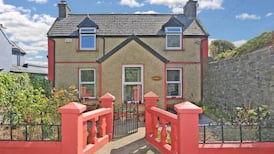Our next-door neighbour recently installed a stove and chimney to a single-storey extension of their two-storey house. The smoke it emits is foul-smelling and clearly detectable, even at ground level.
The chimney does not seem tall enough to allow the smoke to disperse properly. When the stove is in operation, there are clear wafts of smoke blowing laterally at low levels. At these times the air immediately outside our kitchen door is extremely bad and smells toxic. Windows even at ground level need to be shut to ensure that the smells don’t enter the house. I am concerned that it is a source of pollution and a risk to my family’s health.
Is this a situation that we have no alternative but to accept?
The chimney is about 7ft tall, situated on top of an 8ft tall flat-roofed extension. It is positioned about 7ft from the main body of the house. The house itself is a standard semidetached.
‘Forget about glamour’: Jonathan Anderson offers advice to would-be fashion designers as he receives TCD honour
Death of Pope Francis: Derek Mooney leads RTÉ’s coverage to intermittently jaw-dropping effect
Chob Thai restaurant, Clontarf: The most memorable thing here is the bill
Careless People: The controversial book is shocking and reveals Facebook is far worse than we could have suspected
About 90 per cent of heat produced in an open fire is estimated to be lost through the chimney. Provision of a stove can radically reduce this heat loss. Many new homes now incorporate a stove as part of the requirement for a renewable and sustainable heat source and stoves are regularly being retrofitted into older houses.
The Planning and Development Acts allow the provision of a chimney as exempt development. There are restrictions, however, in terms of separation between chimneys and adjoining structures. Chimneys discharge toxic fumes and there are guidelines regarding how close to a window, vent or door opening a flue can be located. This is covered under building regulations.
Part J of the building regulations deals with heat-producing appliances. The associated technical guidance document gives minimum separation distances between chimneys and adjoining buildings. Part J outlines a prohibited zone into which a chimney should not discharge.
Diagram 2 in the guidance document shows how this prohibited zone is comprised. This generally depicts a zone bounded by a line which is offset from the back wall of the adjoining house by 2,300mm. The top of this zone is formed by a line projected down from the upper-level eaves on the main house to an offset point 10,000mm along from the eaves of the lower extension structure. To be compliant, chimneys should project and discharge at least 600mm above this zone.
Using the dimensions you have provided together with typical dimensions for a standard semidetached house, it appears that the chimney you describe may be discharging into the “prohibited zone”. The limited offset from the back wall together with the low height of the chimney may mean that the chimney is noncompliant.
The closer the chimney gets to the back wall of the two-storey section of the house, the higher it would need to be to avoid this prohibited zone. Trees, topography, building shape and height can all vary and have an effect on wind patterns, and can impact on how smoke behaves.
You should have your individual case assessed by a chartered building surveyor who will be able to determine if the chimney is discharging within the prohibited zone and make recommendations on how this can be corrected, if necessary.
Each case is different and while the guidance document sets out to demonstrate best practice, each individual case would need to be looked at to determine if the construction meets the guidelines and if not what corrective action can be implemented to solve the problem.
If your neighbour’s chimney has resulted in minimum requirements being breached, you should draw this to their attention immediately and seek that the flue be altered or raised and brought into compliance with the building regulations.
Stoves are a great addition to any home, but it is important that they are installed correctly, safely and in accordance with building regulations to prevent a hazard to occupants and neighbours. The placement of chimneys should be such that a nuisance is not created.
Noel Larkin is a chartered building surveyor and a member of the Society of Chartered Surveyors Ireland













